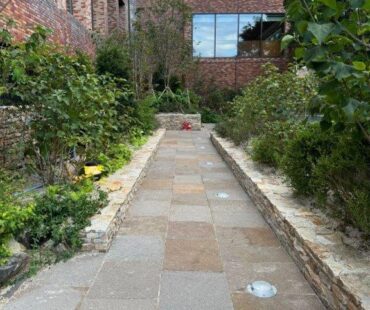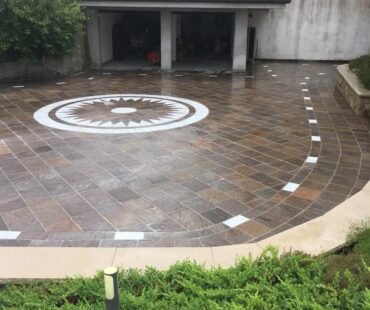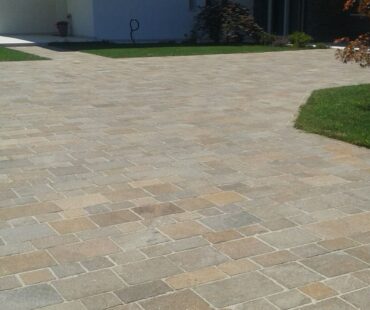Outdoor porphyry floor tiles with sawn edges and rough surface
Split porphyry floor tiles are rectangular tiles machine splitted. They can be used outdoor in a wide range.
Porphyry floor tiles are an excellent choice for outdoor flooring for their unique properties and durability. Porphyry is a volcanic rock that is characterized by great hardness and durability, making it ideal for outdoor use. These tiles are particularly valued for their ability to resist adverse climatic conditions such as frost, rain and UV radiation without suffering significant damage.
In addition to their resistance, Porphyry tiles also offer a natural and refined aesthetic. The variety of the color spectrum ranges from gray to red and brown, and allows you to create harmonious and individual objects based on your own aesthetic taste. This material fits perfectly into various architectural projects, from gardens, driveways, terraces up to urban design.

The surface of Porphyry tiles is naturally non-slip, making it safe to walk on even when wet. This feature is particularly important to ensure safety in pedestrian areas and high-traffic areas. In addition, Porphyry is easy to maintain: regular cleaning with water and neutral soap is generally enough to maintain its excellent condition over time.
In summary, Porphyry tiles used for outdoor flooring combine functionality and aesthetic beauty, representing a durable and versatile solution. Thanks to their resistance to weather and wear, as well as their ability to add visual accents to outdoor spaces, these tiles are a sophisticated choice for both residential and commercial properties.
Advantages of Porphyry tiles
Lay down outdoor Porphyry tiles offer numerous advantages that make them the ideal choice. First of all, Porphyry is an extremely resistant and durable material that can resiste adverse climatic conditions and wear and tear over time. This characteristic makes it perfect for high-traffic areas such as driveways, courtyards and squares. In addition, Porphyry has a natural resistance to environmental agents, which ensures minimal maintenance and always a flawless appearance.
Another key advantage of Porphyry tiles is their aesthetics. They are available in different sizes and finishes, so it is possible to create elegant and sophisticated flooring that integrates perfectly with the environment. The chromatic variety of Porphyry also allows you to create customized designs and patterns that give outdoor spaces a unique touch. The non-slip surface also offers greater safety and reduces the risk of falls, even when wet.
Since it is a natural stone, its extraction and processing has a lower environmental impact compared to other building materials. In addition, the long lifespan of Porphyry helps to reduce the waste generated by the frequent replacement of flooring materials. These Porphyry tiles are not only an aesthetic and functional choice, but also environmentally sustainable.

Types of Porphyry Tiles
Outdoor Porphyry tiles come in a variety of shapes and sizes, making them the perfect choice for a wide range of projects. The most frequently are split edges or sawn edges for a more modern look. Split Porphyry tiles are often used in rustic or traditional projects, adding a natural and rustic touch to outdoor areas such as gardens and driveways. The sawn slabs are preferred for more modern projects due to their precision and uniformity. Regardless of the finish chosen, all Porphyry tiles share the same characteristics of high weather resistance, natural slip resistance and long durability. This makes Porphyry an excellent solution for those looking for a beautiful and functional outdoor flooring.
How to install Porphyry tiles?
Paving Porphyry tiles outdoors requires precision and attention to ensure a resistant result for a long time. First of all, it is important to prepare perfectly the subfloor. This must be stable, well compacted and free of dirt. The substrate is usally a layer of gravel or sand is used as the subfloor, which will be compacted with a vibrating plate to obtain a uniform surface.
A thin streight of cement mortar or sand cement is then applied. Depending which type of laying chosen: dry or wet. By dry laying, the tiles are simply laid on the sand and the joints will be filled up with fine sand. By wet laying the tiles are attached to the subfloor with cement mortar, this giving better stability.
After the subfloor is prepared, the laying of the Porphyry tiles begins. It is important to start in a corner and work carefully, maintaining the distances between the tiles to create a regular joint pattern. To ensure the uniformity of the joints, it may be useful to use spacers. After laying the tiles, you must tap them lightly with a rubber hammer to ensure that they be attached to the subfloor.
Now the grouting takes place. The spaces between the tiles will be filled up with a special mixture which may vary depending on the climatic conditions and the intended use of the finished floor. After applying the grout, it is important to remove immediately the excess grout from the tile surfaces before it has completely dried.


















